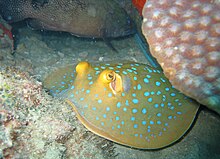
Back سمك الرقيطة Arabic Pagi BCL Stingray English Myliobatoidei Spanish لقمهماهی Persian Myliobatoidei French ಸ್ಟಿಂಗ್ರೇ Kannada 매가오리아목 Korean അടവാലൻ തിരണ്ടി Malayalam Орляковидные Russian
| Stingrays | |
|---|---|

| |
| Southern stingray, Dasyatis americana | |
| Scientific classification | |
| Kingdom: | |
| Phylum: | |
| Class: | |
| Subclass: | |
| Order: | |
| Suborder: | Myliobatoidei
|

The stingrays are a large suborder of the rays. They are cartilaginous fish related to sharks. They are in the suborder Myliobatoidei of the order Myliobatiformes, which consists of nine families.[1]
Most stingrays have one or more barbed stings on the tail, which is used only for self-defence. The sting may reach about 35 cm, and its underside has two grooves with venom glands.[2] The sting is covered with a thin layer of skin, the sheath, in which the venom is held.[3] A few members of the suborder, such as the manta rays and the porcupine ray, do not have stings.[4]
Stingrays are common in coastal tropical and subtropical marine waters throughout the world. There are species in warm temperate oceans, and some found in the ocean. Some live in fresh water. Most stingrays live at or near the bottom of the water, but some are pelagic.[5]
- ↑ Gross, Miriam J. (2006). The Stingray. New York: Powerkids Press. ISBN 9781404231900.
- ↑ Ternay, A. "Dangerous and Venomous Aquarium Fish" (PDF). fishchannel.com. Archived from the original (PDF) on 2014-07-22. Retrieved 2011-09-15.
- ↑ Meyer, P. (1997). "Stingray injuries". Wilderness Environ Med. 8 (1): 24–8. doi:10.1580/1080-6032(1997)008[0024:SI]2.3.CO;2. PMID 11990133. S2CID 260140923.
- ↑ Froese, Rainer, and Daniel Pauly, eds. 2009. "Mylobatoidei" in FishBase. FishBase online
- ↑ Bester, C; Mollett, H.F.; Bourdon, J. "Pelagic stingray". Florida Museum of Natural History, Ichthyology department. Archived from the original on 2016-01-15. Retrieved 2011-09-15.